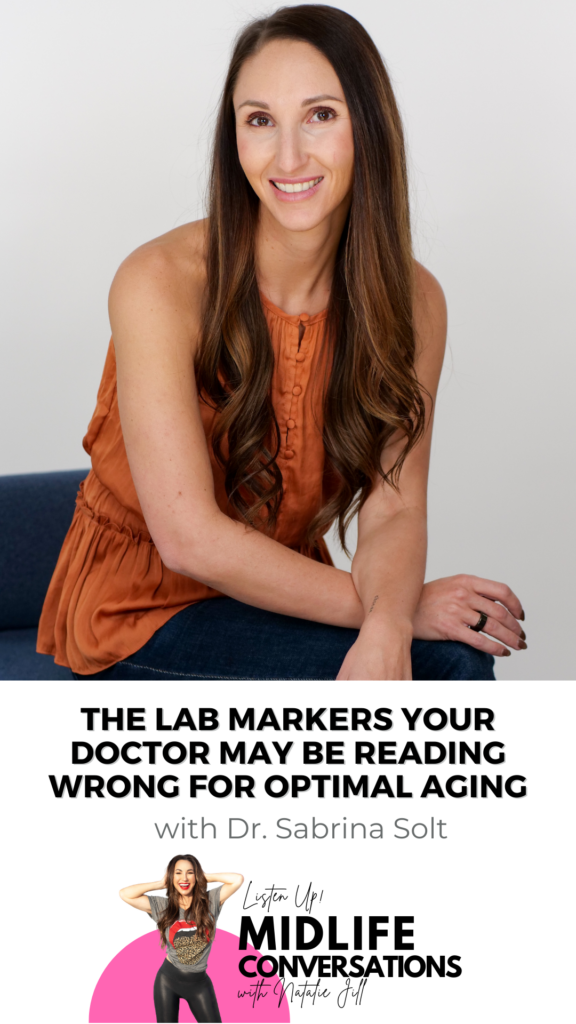The Lab Markers Your Doctor May Be Reading Wrong for Optimal Aging with Dr. Sabrina Solt
Today on Midlife Conversations, I chat with Dr. Sabrina Solt, a specialist in regenerative and anti-aging medicine, about important lab markers frequently overlooked by general practitioners. We dive into the significance of ferritin levels, debunking common misconceptions about low ferritin and its benefits for optimal aging. Sabrina explains the nuances of cholesterol, emphasizing the importance of triglyceride levels, the HDL to LDL ratio, and the implications for middle-aged health. We also touch upon hormonal changes, including the role of estrogen and cortisol, and how to interpret thyroid markers for better health management. The discussion rounds out with insights on the benefits of peptides for midlife wellness and practical tips on advocating for our health.
Dr. Sabrina Solt specializes in regenerative and anti-aging medicine and knows all things for optimal labs in midlife. There is a big difference between “normal” and “optimal” lab numbers and she not only GETS IT, but is here to help us better understand what we should be looking for and testing for optimal health in midlife. It can get really confusing with all of the information out there – much of which contradicts the rest. For example, I’ve seen time and time again that low ferritin is a big issue, yet on the other hand, Dr. Solt says it’s amazing to have low ferritin for age optimization. I find the school of thought differences SO interesting and I am excited to have her dive deeper into this today.

The Difference and Connection Between Iron and Ferritin in Midlife
When you test for iron you are testing for circulating iron. Circulating iron is important for our oxygen carrying capacity for our red blood cells. Low iron can cause anemia, especially in women who are still menstruating. But in post menopausal and midlife women, when we are no longer losing a lot of iron each month, yet we are still consuming it in our foods. When this happens, we start to store it in something called “ferritin” which is a bunch of iron molecules that gets stored in tissues (like our liver).
Iron itself is something that can be inflammatory or oxidative (like a rusty truck in the yard). Likewise, when we have this build up in our system, we can get oxidative damage or oxidation in our system. This can create other things like insulin resistance, cardiovascular damage, predisposition to certain types of cancers, etc. As you age, these numbers tend to increase. There is a “sweet spot” at which surpassing can cause more damage than not.
Iron Fortified Food in the United States
You can still have functional anemia even with high ferritin stores. A lot of people don’t know this but all grains in the United States legally have to be fortified with iron. What they use to do this is metallic, non-bioavailable iron that is not able to be absorbed. When we consume iron that the body cannot use and process, it will store it as ferritin.
Leafy greens, like spinach, can also be tough forms of iron to absorb and convert. The high oxalates from the spinach can actually block mineral absorption and cause mineral deficiencies in the body. When you have a copper deficiency, you have a higher tendency to store ferritin. Copper deficiency in women can look like sagging skin and wrinkles, as it’s one of the important things we need for optimal skin health.
Is Having Low Ferritin a Good Thing or a Bad Thing in Midlife?
You can request a full iron panel from your doctor. If your circulating iron is good, your iron binding capacity is good, indicating that your body is recycling it appropriately, then having a low ferritin isn’t necessarily a bad thing. In men, because they don’t lose high amounts of blood like women, a lot of heart issues later in life, and gout, are rooted in excess ferritin. If your ferritin levels are lower in midlife and beyond, you are contributing less to your overall oxidative stress.
What About High Cholesterol in Midlife?
A high cholesterol panel is almost par for the course by the time you get to midlife. Cholesterol is a building block and is an essential nutrient; it’s the starting molecule for ALL of your sex hormones in your body (testosterone, estrogen, progesterone, cortisol, etc.). When you hit middle age and these hormones begin to decline, it makes sense that you body would turn up the production of cholesterol. Your liver makes 70-80% of your cholesterol levels and you get 20-30% from your diet – at the most.
In addition to being the building block for your sex hormones, it’s also the building block for all of the cells in your body, and the lining of all of your nerves. When we see cholesterol going up, the question isn’t really how do we lower it – it should be why is it going up in the first place? How do we support the body in a way that doesn’t require cholesterol to increase?
When you test, you have Total, LDL, HDL, and Triglycerides. Triglycerides are the most menacing value on the panel and are THE best way to see future indications of health concerns. Once your triglycerides are over 80, you are at a level of insulin resistance. As we know, insulin resistance is a big deal as we age.
The REAL problem, though, is when your typical doctor runs your tests, sees “high cholesterol”, treats you for that, and then causes your body to essentially stop the building block of all repair processes. You will see your menopause symptoms increase, your joints will hurt, your brain will be foggy, etc. It’s very very very important to get a clear picture of your cholesterol’s real picture.
If You’re Worried About Your Cholesterol You Should:
- Get tests. What are your triglycerides?
- Do you have a 1:1 ratio of triglycerides and HDL?
- Get a coronary artery scan to make sure you are a zero
This and sooo much more (hormones, thyroid, cortisol, A1C, etc.) on this episode!
About Dr. Sabrina Solt
Doctor, speaker, and health-focused content creator Dr. Sabrina Solt specializes in helping you reach your most optimal state. Dr. Sabrina Solt has specialized in regenerative and anti-aging medicine since 2013. In 2020, she founded Stem Cell Therapy Professionals, a clinic in Scottsdale, AZ that is dedicated to providing the highest level care in the industry.
So what does that mean for you? With thousands of completed treatment sessions, she provides a high level of skill, expertise, strategy, and elegance. Dr. Solt assists people from all over the world who want to recover from musculoskeletal pain, in addition to other concerns. She focuses on optimizing her patient’s health to look, feel, and become biologically younger.
Learn more about Dr. Sabrina Solt at:
Dr. Sabrina Solt IG: www.instagram.com/drsolt
Dr. Sabrina Solt Website: www.stemcelltherapypro.com
🎙️ Want to listen in on a LIVE recording of Midlife Conversations? You can listen in, hear the episode unedited prior to launch AND stay on and ask your questions to the guest! (Don’t worry! We won’t air your questions so you can stay anonymous!) Learn more HERE
